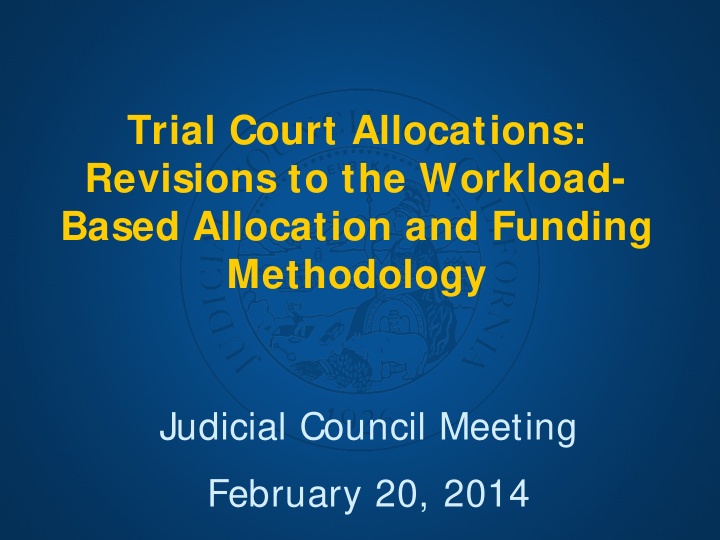



Trial Court Allocations: Revisions to the Workload- Based Allocation and Funding Methodology Judicial Council Meeting February 20, 2014
Trial Court Budget Advisory Committee Trial Court Budget Advisory Committee took action on • its recommendations to the council at its January 16, 2014 and January 30, 2014 (via e-mail) meetings. All the recommendations were developed by the Funding • Methodology Subcommittee All of the recommendations presented today were • approved unanimously.
Recommendation 1 Approve the WAFM’s use of the most current three- • year average salary data for determining each court’s Bureau of Labor Statistics (BLS) salary adjustment.
Recommendation 2 For courts whose WAFM workload need is less than • 50 full-time equivalents (FTEs), adopt a per-FTE dollar allotment floor that is the median BLS-adjusted average FTE dollar allotment of all courts with a need of fewer than 50 FTEs.
Recommendation 3 Establish an absolute funding floor ($750,000 in fiscal • year 2014–2015) and fund the shortfall between a court’s actual WAFM allocation and the absolute floor by reducing, pro rata, the allocations of courts that do not qualify for an absolute or graduated funding floor.
Recommendations 4 and 5 Establish a graduated funding floor that is based on a • court’s WAFM funding need ($875,000, $1,250,000, and $1,875,000 in fiscal year 2014–2015) and fund the shortfall between a court’s actual WAFM allocation and the applicable graduated floor by reducing, pro rata, the allocations of courts that do not qualify for an absolute or graduated funding floor. Adopt a cap on the amount of the allocation • adjustment that courts eligible for funding at the graduated floor level can receive in a given fiscal year, as described later in this report.
Recommendation 6 Eliminate the cluster 1 courts’ exemption from having • their historical base allocations be reallocated using the WAFM.
Recommendation 7 Direct the Judicial Branch Resource Needs • Assessment Advisory Committee (JBRNAAC) to study special circumstance cases in their next round of workload study updates and direct the Court Executives Advisory Committee to work with the JBRNAAC to determine how best to collect the data necessary to support the study and, when a determination is made, direct the trial courts to start reporting such data.
End of Presentation
Recommend
More recommend